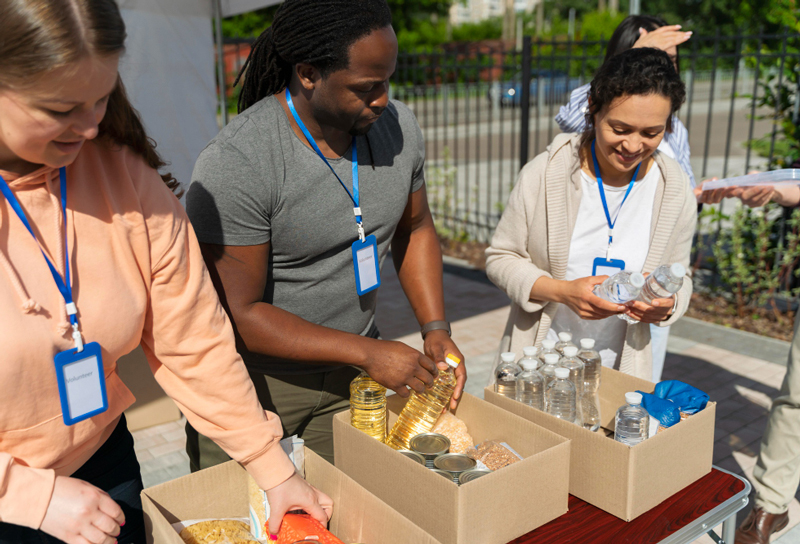No matter your field, the work you do affects the community in which you work. Whether you are a non-profit, a real estate developer, a college, a hospital or a candidate for public office, creating and maintaining positive connections to the community touched by your activities is an essential component of success. An effectual community action strategy can not only pave the way to a smoother process, but ensure a better relationship.
GAC has decades of experience in community engagement and has helped maintain communications and relationships between a wide variety of clients and their communities.

An inevitable side-effect of any construction project, especially in a densely populated city like New York, is the havoc it can wreak on the daily lives of its neighbors, affecting traffic patterns, parking, walkways and noise levels, and creating tension between development and construction companies and the community.
For decades, GAC has served as a liaison between developers and construction firms, and communities affected by their projects. We craft and implement well-planned community outreach strategies that help ease community resistance and build support for projects among neighbors, local elected officials, and community boards, ensuring an effortless process.
By definition, running for public office involves convincing voters that you would work for their best interests, making community engagement the basic component of any political campaign.
From townhall meetings, to community events, meet-and-greets and simply mingling with community members, candidates can become familiar with potential voters, learn what issues are important to them, devise strategies and plans to help, if elected, and communicate these plans to the communities they are running to represent.
Over the years, GAC has managed communications for countless political campaigns, helping many candidates get elected and re-elected for office, including the US Congress, NY Senate and Assembly, NY City Council, borough presidents and the judiciary.


The primary purpose of most non-profit organizations is to serve their communities, be it running programs for youth or senior citizens, community centers, health, education or cultural initiatives or any number of other activities that help improve people’s lives.
It may seem that the work of such organizations would make the case for themselves with the communities, and it might.
Yet, actively seeking to create a holistic relationship with communities can have numerous benefits, including marshalling support for your organization and its causes, making it easier to implement projects, drawing community members to participate or sign up for services, and obtain funding. Over time, GAC has helped many non-profits build and maintain positive dynamic relationships with communities they serve.
Having a major institution such as a hospital or a college campus in your neighborhood can have a significant impact on the community.
Both can be great for businesses big and small, attracting customers to restaurants, pharmacies, florists, dry cleaners, supermarkets, and other small businesses. Both can also bring noise, traffic and a bit of overall chaos.
Partnering with the neighbors to find ways to capitalize on the rewards while keeping problems to the minimum, helps institutions positively contribute to surrounding communities and build good will among the neighbors.

Community engagement is the process of working collaboratively with groups of people who share a common interest, situation or location. The purpose of community engagement is to address issues affecting one’s community including influencing systems, policies, programs and practices.
Transparency: Clearly and openly sharing information about your plans, decisions, and goals helps build trust and demonstrates respect for the community. This includes being honest and forthcoming, even when the news is difficult.
Open Lines of Communication: Listening and being responsive to the concerns of the community is fundamental to successful community engagement.
Inclusive Partnerships: Collaborating with community groups, organizations, and individuals helps ensure that the community feels heard and represented. This may be accomplished by actively seeking out partnerships with those who may be most impacted by your actions, and by keeping an open line of communication so interested groups or individuals feel they can come to you with concerns or ideas.
Empowerment: Community engagement should aim to empower community members to take an active role in improving their own community. This can involve providing resources, support, and opportunities for leadership and decision-making.
Cultural Competence: Understanding and respecting the culture, values, and beliefs of the community is crucial to building a positive relationship with its members.
Responsiveness: Taking action in response to community input and feedback demonstrates that the voices of the community are truly being heard. This helps build trust and strengthens relationships over time.
Sustainability: Community engagement is an ongoing process, which requires a long-term commitment to building and maintaining relationships with the community.
Community engagement is an instrumental component for successful implementation of projects or initiatives affecting the community. It fosters goodwill, paves the way to a smoother process and can help build long-term relationships and support, leading to more sustainable impact and initiatives.
A successful community engagement effort can help individuals or organizations make better informed more well-rounded decision that address community needs and concerns, thus increasing community trust and support for the project. This can lead to more equitable outcomes, which may help enhance the reputation of the organization running the project.
An engaged community that trusts an individual or an organization can also provide unique insights and ideas, which can lead to innovative solutions that may not have been considered without such input.
If you have a project that would have a significant impact on the community, such as building new or changing an existing structure, seeking change in laws or regulations affecting the community, or running for elective office, getting the community on your side can be the key to successfully reaching your goals.
Some other indicators that you need a community engagement campaign may be lack of community knowledge, struggling to gain the trust or support of the community, or if there is tension or conflict between you or your organization and members of the community.
There are many benefits to hiring a consultant for community engagement, including expertise, community connections, and objectivity, to name a few.
A consultant might be particularly effective for community engagement when tension exits between the client and the community, serving as a mediator and providing objectivity of an outside party to facilitate difficult conversations and negotiate mutually beneficial solutions.
Another benefit of hiring a community relations consultant is time. Building relationships with the community can be a time-consuming tedious endeavor and hiring a consultant allows the client to focus on their project while the consultant filters and responds to community concerns, organizes meetings and disseminates communications.
GAC has conducted many successful community engagement campaigns over the years which served a pivotal role in building trust and getting the community on our clients’ side.
We are well familiar with the communities where we work and have been instrumental in helping many organizations and individuals build essential relationships within the communities whose support they need. Our credibility among and connections with key community leaders, including elected officials, and a thorough understanding of the communities’ unique needs and relationships enable us to tailor the message and reach the right target audience, building good will and productive partnerships.